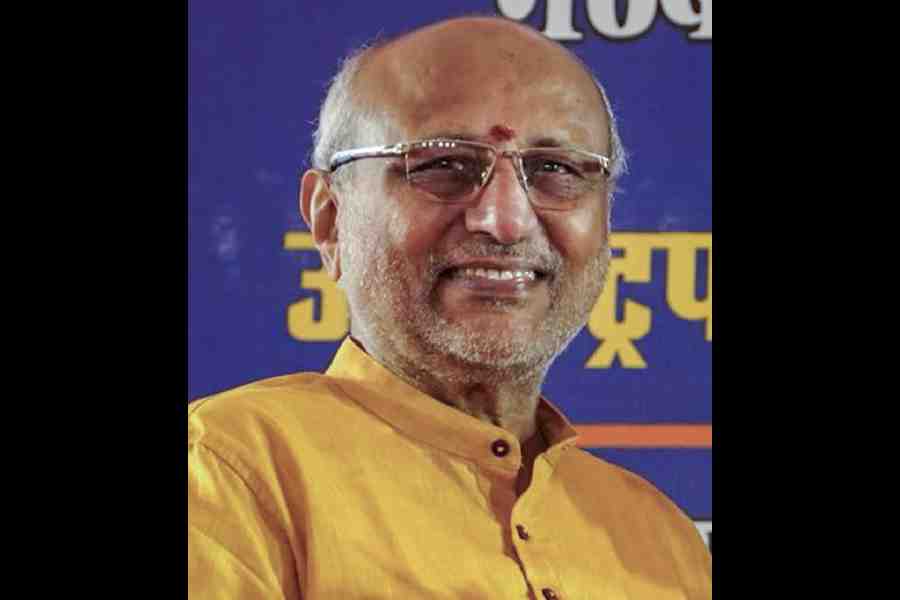 |
| Gita Dey at a shoot. Picture by Aranya Sen |
Gita Dey cannot yet rest on her laurels. There is the creative thirst, as well as financial need, reports Sebanti Sarkar
Very little plaster covers the old brickwork. The doors and windows in front are locked. The boys playing football in the lane outside smugly say: “No one lives here anymore.” But the phone rings inside somewhere and you are told to climb up the back stairs to the second floor. The stairs, dark and narrow, twist and lead to a metal door, shut. Some knocking, and you are led through a narrow passage to a small bedroom where Gita Dey has just woken from her afternoon siesta.
The room is a humble muddle. Her white hair is like a cloud. But after a career spanning over 60 years Dey is proud of her countless stage and screen appearances in the works of Satyajit Ray, Ritwik Ghatak, Sisir Bhaduri, Ahin Chaudhuri, Tapan Sinha, Manoj Mitra, Gyanesh Mukhopadhyay and Rituparno Ghosh. She still acts in serials and though the AIR plays (to which she contributed since the mid-50s) have stopped and HMV no longer brings out audio drama records, she does play reading sessions.
Dey is mostly remembered as the redoubtable character actress who often got cast as the nasty mother-in-law, stepmother, wife or daughter-in-law — making the audience’s blood boil. But she could as easily evoke sympathy and handle a comic role. She is, at 76, a powerful actress still raring to go. But she has very little to show for all those years of dedication to the stage and screen.
A belated shower of awards clutters her glass showcase and in the clothes cupboard is tucked away the Sangeet Natak Academy lifetime achievement award. “I am running out of space for these things... yes, they make me happy, but what would I not give for a plum role instead!” smiles the septuagenarian. “One doesn’t care any longer about good or bad roles, one just has to be grateful they come at all because, quite frankly, I need to earn.”
Dey started young. “Next to our house on Grey Street lived Radharani Debi, who reigned as both actress and singer. I was barely three when I began to sing along with her. One day I was singing one of her songs, when she offered to teach me to sing and act. We were not well off and my father encouraged me. So at six I was learning dance with Nihar Bala, singing and dancing being essential to an actress’s career,” she says.
Radharani Debi took her to Natyaniketan where Naresh Mitra gave her a role in Kalindi. Her screen debut was Dhiren Ganguli’s Ahuti (1937).
Dey’s acting career was stalled for a few years after she was married off to Ashim Kumar Dey, a Taltala businessman. At 19, however, she was back to the stage fending for herself and her three children. “I had to turn back to theatre for a living,” says Dey. Friend and actress Jharna Debi took her to Srirangam Theatre and introduced her to Sisir Bhaduri, whom she considers her guru, along with Naresh Mitra and Ahin Chaudhuri. Though part of many major stage productions like Srikanta, Dampati, Na, Mallika, Joi Ma Kali Boarding, up to Badsahi Chaal (her last play) at Rangana in 1996, Dey cherishes her years at the Star under Debnarayan Gupta. “There was enough respect for stage artistes, though the pay was measly,” says Dey.
She had an illustrious career in films. Re-introduced to films with Shilpi in the mid-50s, Dey acted in Ritwik Ghatak’s Meghe Dhaka Tara, Komalgandhar and Subarnarekha. But Daini, directed by Manoj Bhattacharya, is Dey’s favourite. “It was the only film in which I got to play the heroine.”
Shooting with Ray was an experience. Teen Kanya (in Samapti she was Aparna Sen’s mother) showed her “what cinema can be”. She is proud of her roles in Tapan Sinha films like Haatey Baajarey, Jotugriha and Ekhonee and she is happy looking back on everything from Saat Paakey Bandha, Kedar Raja, Sagar Sangramey to Parineeta, Sunglass and Tollynite.
“Everyone calls me Ma or Gitama in the industry. Youngsters draw up chairs for me. They show concern for my osteoporosis and heart problem... But my memory is still sharp. I have no problem coping with long dialogues,” she says. Her voice trails off as her sister switches on the light and the tiny TV set for the Sunday matinee film. No, it is not any film featuring her. Just a dubbed Hindi film. “Now it is all so simple, one only has to remake or better still dub films in other languages into Bengali — English, Japanese, Tamil, Telugu…anything will do,” Dey mutters sadly.










